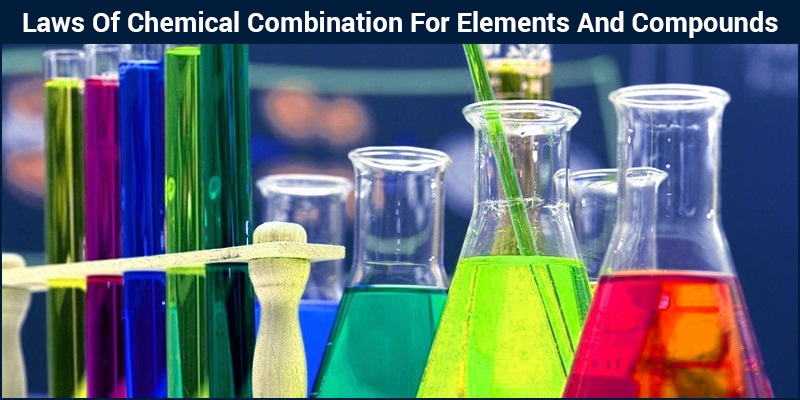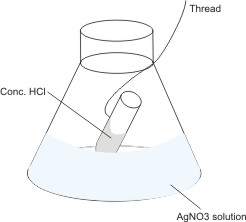Back to: CHEMISTRY SS1
Welcome to class!
In today’s class, we will be talking about the laws of chemical combination. Enjoy the class!
LAWS OF CHEMICAL COMBINATION

CONTENT
- Law of conservation of mass
- Law of definite proportion or constant composition
- Law of multiple proportions
LAW OF CONSERVATION MASS
This law states that during chemical reactions, matter can neither be created nor destroyed but changes from one form to another.
EXPERIMENT TO VERIFY THE LAW
AIM: To verify the law of conservation of mass
THEORY: The equation of the reaction chosen for the study is as follows:
HCl(aq) + AgNO3(aq) → AgCl(s) + HNO3(aq)
White ppt
APPARATUS: Weighing balance, conical flask, small test tube, string cork stopper.
REAGENTS NEEDED: Solutions of HCl and AgNO3 stored in two different reagent bottles.
METHOD: The dilute HCl is poured into a conical flask. The small test tube is filled with AgNO3 solution and by means of a string tied around the neck of the test tube, it is suspended inside the conical flask containing the acid in such a way that the two solutions do not mix together. The conical flask and its content are weighed using a weighing balance and the result recorded. The two solutions are mixed together by swirling the conical flask and the weight of the conical flask and its content is taken again.

RESULT: After mixing the two solutions, a white precipitate of AgCl was formed indicating that a chemical reaction has taken place.
DISCUSSION: The masses of the conical flask and its content before and after the reaction remained the same indicating that the mass of the reactants equals that of the products.
CONCLUSION: Since the two masses obtained are equal, it confirms that matter was not created nor destroyed during the chemical reaction.
LAW OF DEFINITE PROPORTION OR CONSTANT COMPOSITION
The law states that all pure samples of a particular chemical compound contain the same elements combined in the same proportion by mass.
EXPERIMENT TO VERIFY THE LAW
AIM: To verify the law of definite proportion
APPARATUS: Crucible, test tube, combustion boats, combustion tube, weighing balance, Bunsen burner, U-tube and two retort stands with clamps.
REAGENTS NEEDED: CuCO3 crystals, Na2CO3 solution, Cu(NO3)2 solution, dry hydrogen gas and CaCl2 crystals.
METHOD: Two samples of black CuO are prepared using different methods. Sample A is prepared by placing the CuCO3 crystals in a crucible and heating it strongly until it decomposes into black CuO. The equation for the reaction is:
CuCO3(s) → CuO(s) + CO2(g)
Sample B is prepared by reacting a solution of Na2CO3 in a test tube with a solution of Cu(NO3)2. A green precipitate of CuCO3 is formed. This is filtered off and then heated strongly in a crucible to obtain black CuO. The equation for the reaction is:
Na2CO3(aq) + Cu(NO3)2 → CuCO3(s) + 2NaNO3(aq)
CuCO3(s) → CuO(s) + CO2(g)
The two samples of black CuO are placed in two dried and weighed combustion boats labelled A and B and weighed again. These boats are then placed in a combustion tube and heated. A stream of dry hydrogen is passed through the combustion tube to reduce the CuO to metallic Cu. After heating for sometimes, a reddish-brown residue shows that all the CuO has been reduced to metallic copper. The flame is removed but the passing in hydrogen gas continues to prevent the re-oxidation of the hot copper residues by atmospheric oxygen. Any water formed during the reaction is absorbed by the fused CaCl2 in the adjacent U-tube. When the boat is cool, the weight of it is taken. From the results, the percentage of Cu in each sample is calculated.
RESULT: Assuming the following result was obtained:
Sample A B
Mass of boat 3.16g 3.31g
Mass of boat + CuO 5.15g 5.29g
Mass of boat + Cu 4.76g 4.90g
Mass of CuO = (ii) – (i) 1.99g 1.98g
Mass of Cu = (iii) – (i) 1.60g 1.59g
% of Cu in CuO = (1.60/1.99) x 100 = 80.40% (1.59/1.98) x 100 = 80.30%
Therefore, % of Cu in CuO = 80% 80%
% of O2 in CuO = 20% 20%
DISCUSSION: The % of Cu residue in the two samples is approximately 80% irrespective of the method of preparation of the CuO samples.
CONCLUSION: In pure CuO, Cu and O are always present in a definite proportion by mass of approximately 4:1.
LAW OF MULTIPLE PROPORTIONS
This states that if two elements combine to form more than one compound, the masses of one of the elements which separately combine with a fixed mass of the other element are in a simple ratio
EXPERIMENT TO VERIFY THE LAW
AIM: To verify the law of multiple proportions
APPARATUS: Combustion boats, combustion tube, weighing balance, Bunsen burner, U-tube and retort stand with clamp
REAGENTS NEEDED: Cu2O crystals, CuO crystals, dry hydrogen gas and calcium chloride crystals
METHOD: The two boats are dried and weighed. Cu2O is placed in one and labelled A and CuO is placed in the other and labelled B. The two boats are weighed again and placed in a combustion tube to reduce the oxides to copper by passing hydrogen gas into the combustion tube. When the samples are cooled, the residues obtained are weighed.
RESULT: Assuming the following result was obtained:
Sample Cu2O CuO
Mass of sample (oxide) 3.04g 1.91g
Mass of Cu residue 2.55g 1.35g
Mass of oxygen removed from oxide 0.49g 0.53g
CALCULATION: Calculating the various masses of copper which combine separately with fixed mass (say 1g of oxygen)
For Cu2O:
0.49g of O2 combines with 2.55g of Cu
1.0g of O2 will combine with Xg of Cu
Xg of Cu = (2.55g x 1.0g) / 0.49g = 5.20g
For CuO:
0.53g of O2 combines with 1.38g of Cu
1.0g of O2 will combine with Xg of Cu
Xg of Cu = (1.38g x 1.0g) / 0.53g = 2.60g
Oxides of copper Cu2O CuO
Mass of copper 5.20g 2.60g
The ratio of copper 2 : 1
CONCLUSION: The masses of copper which combines with a fixed mass of oxygen in Cu2O and CuO are in a simple ratio of 2:1.
GENERAL EVALUATION/REVISION
- State the law of (a) definite proportion (b) multiple proportions
- Balance the following chemical equation
- Ca(HCO3)2(s) → CaCO3(s) + H2O(l) + CO2(g)
- SO2(g) + H2O(l) + 02(g) → H2SO4(aq)
- Determine the oxidation number of (a) Cu in CuCO3 (b) P in H3PO4 and name the compound
READING ASSIGNMENT
New School Chemistry for Senior Secondary School by O.Y. Ababio, Pg 34-37
WEEKEND ASSIGNMENT
- All pure samples of chemical compound contain the same element in the same proportion by mass is the law of _____ A. definite proportion B. reciprocal proportion C. multiple proportions D. conservation of matter
- What is used to measure the mass of atom and molecules? A. Beam balance B. Spring balance C. Chemical balance D. Mass spectrometer
- What is the ratio by mass of oxygen and hydrogen in 1 mole of water? A. 3:1 B. 2:1 C. 1:2 D. 2:4
- In two separate experiments, 0.18g and 0.36g of chlorine combine with a metal M, to give A and B respectively. An analysis showed that A and B contain 0.10g and 0.20g of M respectively. Which law is illustrated by the data? A. Law of multiple proportions. B. Law of conservation of mass. C. Law of constant composition. D. Law of simple proportion
- An element E forms the following compounds with bromine: EBr2, EBr3, and EBr4. This observation illustrates the A. Law of conservation of mass. B. Law of definite proportion. C. Law of multiple proportions. D. Law of chemical combination
THEORY
- 50g of CuO, when heated in a current of dry hydrogen gas, gave 6.58g of copper and 2.16g of water. Calculate the proportion of oxygen to hydrogen by mass in water.
- Balance the following equations:
C4H10 + O2 → CO2 + H2O
H2SO4 + NaOH → Na2SO4 + H2O
In our next class, we will be talking about Identification and Types of Alloys. We hope you enjoyed the class.
Should you have any further question, feel free to ask in the comment section below and trust us to respond as soon as possible.

Thank you for your efforts
thanks a lot for your efforts
please you did not illustrate with an diagrams to verify the four laws of chemical combination